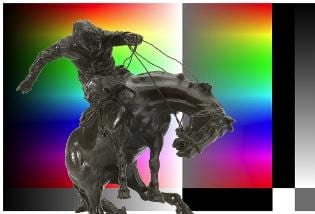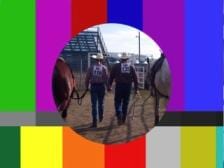
QUEERING COWBOYS. A concept image of Paul Wong's exhibit. Credit: courtesy of Paul Wong
What happens when you take a queer artist from the big city and land him in southern Alberta during the gay stampede?
The answer is 2 Hot 2 Handle.
That’s the title of award-winning multimedia artist Paul Wong’s current installation at the Glenbow Museum in Calgary.
Last year, as part of the museum’s Connections to Collections series, Wong was asked to respond to the Glenbow’s permanent collection, Mavericks: An Incorrigible History of Alberta.
After a series of short visits to the Glenbow and a spontaneous trip to Calgary’s gay rodeo, Wong says the connection between Alberta’s rugged history and the Canadian Rockies International Rodeo — Canada’s only gay rodeo, held just outside of Calgary each year — was inevitable.
“I responded, in the end, to something that was in my face,” says the Vancouver-based artist.
Gay, Chinese and Canadian, Wong is known to explore his various identities in his work and to push boundaries. A self-invented video pioneer, his career spans 30 years. In 2005, Wong received the Governor General’s Award in Visual and Media Art. His work has been shown in exhibitions and festivals around the world and is included in major national and international collections, including the National Gallery of Canada and the Museum of Modern Art in New York.
Knowing very little about cowboy culture, Wong spent a few days in late June taking video footage and still photographs of the 2009 Canadian Rockies International Rodeo. He saw everything from “flaming drag queens to macho cowboys to serious bull dykes — so to speak,” says Wong.
“To see the campsite festooned with flags and colours seemed to make a much more powerful statement out in Alberta, in the grasslands, than say in the gay ghetto of Vancouver, or in other gay ghettos in large urban centres,” says Wong. “It just seemed that much more brave and powerful to me.”
Wong captures this powerful contrast in 2 Hot 2 Handle by fusing images of the gay rodeo with the Glenbow Museum’s western bronze collection. On one screen, Wong projects still photographs and footage from the rodeo while simultaneously projecting photographs of the bronze sculptures onto a second screen. The sculptures, which were created by a variety of local and international artists between the 1880s and mid-1980s, depict cowboys in action and are part of the Glenbow’s permanent collection, Mavericks.
“What’s missing in the Mavericks section is a queerness,” says Wong. “So, I’ve alluded to it, I’ve opened it up, I’ve given permission to say that there was and is a [queer] history.”
In the centre of Wong’s installation, selected sculptures from the western bronze collection are on display in a glass case. Placed within the context of the gay rodeo, the bronze cowboys exude sexuality.
“The fact that they (cowboys) weren’t allowed to be queer, doesn’t mean they weren’t,” says Wong. “[The sculptures] have always had that homoerotic appeal; I think all I’m doing is being more obvious with it.”
Curator Quyen Hoang says Wong’s piece destabilizes stereotypes about cowboys and offers a more complex view of masculinity and gender.
“These static bronzes display a very macho image of the cowboy,” says Hoang. “But [Wong’s] installation introduces sound, movement, energy and metaphorically suggests a more dynamic and shifting notion of gender.”
Behind the projected photographs of the western bronzes are vertical stripes mimicking television colour bars and galloping horses at sunset. The soundtrack is a compilation of clips from the American and Canadian national anthems and the Calgary Stampede song, This Old Hat, performed by Alberta country music singer Gord Bamford. Floating across the images of the gay rodeo is text: Let ‘er buck, Thirsty Beaver, A Hooker and so on. These words and phrases are directly lifted from the titles of the bronzes and from a page of slang in the program of the gay rodeo.
“The whole piece is a double entendre,” says Wong.
Even the title of Wong’s piece takes its name from one of the bronze sculptures, Too Hot To Handle by artist E Hazak. Wong describes the sculpture as a horse standing on its hind legs and the rider holding on for dear life.
“It’s a sexy title,” he says.
At 50 years old, Wong looks back at the past few decades and sees a distinct shift in attitude toward queer Canadians, especially since the legalization of same-sex marriage.
“We’re no longer outlaws,” says Wong, adding that even his own stereotypes about “redneck Alberta” have softened.
“To be 16 right now and queer is very different than being 16 and queer 30 years ago,” says Wong. “We’ve given permission to be what you can be, which means go out and rope cows if you want!”
2 Hot 2 Handle is at Calgary’s Glenbow Museum until Feb 21.
On Jan 28, Calgary’s Fairy Tales Presentation Society will host an evening with Wong in the ConocoPhillips Theatre at the Glenbow. The night will feature a presentation by Wong and a screening of some of his recent work, including Perfect Day, a self-portrait of the artist indulging in drugs; EastVan John, about a man displaced by gentrification; Sally, shot at the China Club in Beijing; and the sexually charged Chelsea Hotel. A dance party, featuring DJs Mollyfi and Krissdoll, will follow at Mango Shiva (218 8th Avenue SW). Tickets for both events are $10 at the door.

 Why you can trust Xtra
Why you can trust Xtra


